- Product
- SEO Content Editor
- SEO Content Strategy
- Content Optimization
- Content Briefs
- AI Assisted Writing
- Keywords Clustering
Preview a demo walkthrough
Outranking the competition with our cutting-edge SEO strategies.
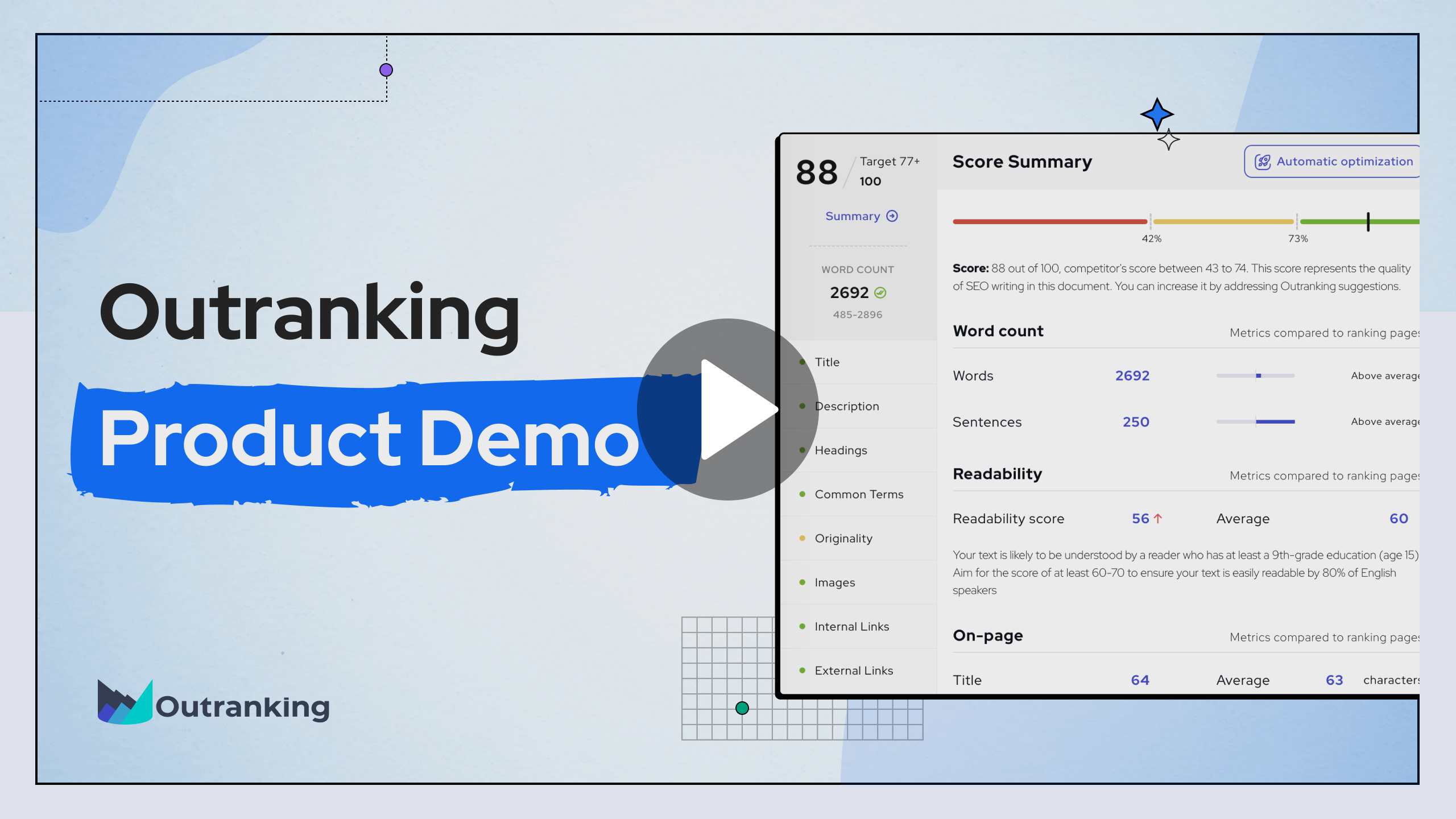
- Pricing
- Resources
- Sign In
- Get Started

How Much Should You Charge for a Blog Post Making Money with Your Content
Table of Contents
Most writers earn pennies while writing world-class content. In fact, the annual wage for 10% of writers in the US is merely $39,610 while the median annual wage for US households was $67,521 in 2020. While most writers think that they should be paid for only the words they write, that’s not the case.

As a writer, you’re not only writing content, but also researching the best keywords, learning SEO best practices, and trying to make irresistible content that ranks. That’s a lot to juggle!
But don’t worry, we’ve got you! Here’s how you can start earning the pay you deserve, every step of the way.
Table of Contents
Differentiating Freelance Writing from Blogging
Though freelance writing and blogging may seem similar, that’s far from the reality. Freelance writers write on multiple niches and work for various websites, while bloggers write for mostly one website on a single specific niche.
Defining Freelance Writing
Freelance writers are the wizards of the writing world and wear many hats to get the job done 🧙. In freelance writing, you work your creative magic to help someone else’s website rank. You create articles, blog posts, or web content for a predetermined rate. Freelancers also write for multiple clients simultaneously, adapting styles to fit different requirements. It’s an exciting world where every project builds your portfolio.
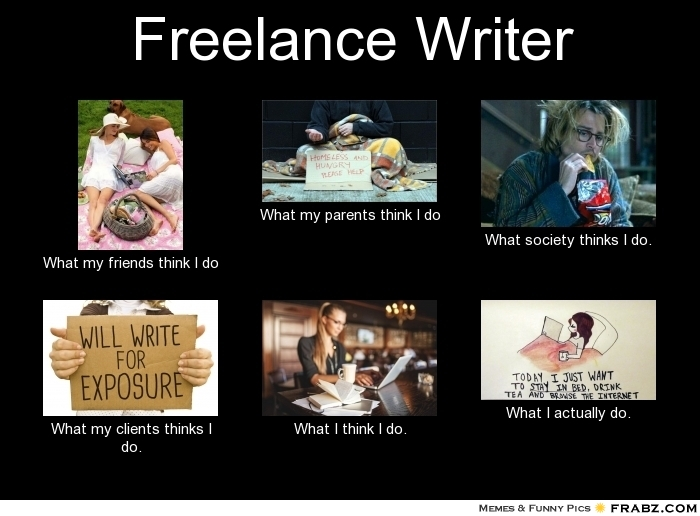
Freelance writers work at their own pace, with the clients and niches they choose, and at their desired rates. Now this meme may tell you that they don’t actually do anything (apart from laying in bed and surfing the internet), but that’s certainly not the case. In reality, more than 30% of Fortune 500 companies work with freelance writers while 70% of small businesses use freelance writing services for their website. So freelance writers are a hidden force that drives both the large companies and small business’ content writing needs.
Understanding How Blogging Works
Blogging captures hearts one post at a time. It’s not simply about writing; it’s about mastering the art of blog post writing. Bloggers are trained writers who have learned to blend entertainment with strategy. While they’re captivating storytellers who win over the hearts of their readers, bloggers also boost your website traffic and ranking. Through years of research and learning, they have honed both their writing and SEO skills to create an immersive blogosphere to drive online presence. Unlike freelance writers, bloggers are highly skilled in one niche. With each post, they’re not just sharing a story — they’re establishing a digital footprint.
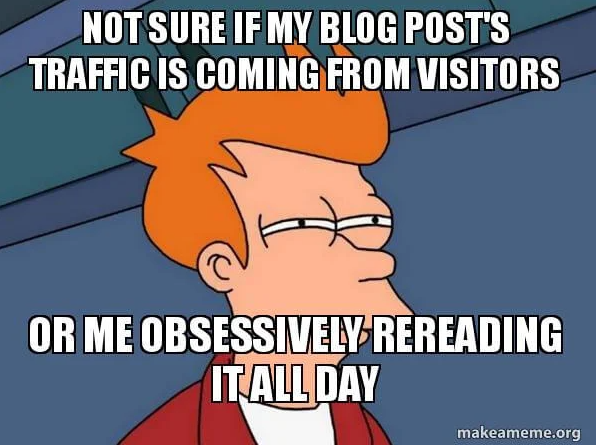
Now you’ve got the difference down, here are 5 steps to guide you on your content writing journey.
1. Know Your Worth in Writing
Before determining your writing service’s rates, you should know your worth and your writing’s value. Your rates must align with the value you provide but try to keep them somewhat flexible to accommodate a client’s budget needs.
Understanding Your Unique Selling Proposition
Out of the 54,000 writers in the US, what makes you special and why should clients hire you? This can be explained using a Unique Selling Proposition (USP).
Your USP is just that: unique. It sets you apart from competitors. It could be your blog design, niche expertise, or how well you implement SEO in crafting engaging content — all critical elements in startup growth. Nail it down and acknowledge what makes your content special to increase engagement.
Once you’ve got it, promote this USP when marketing your blog writing service. You’re not just a writer; you’re a writer with a unique advantage and an eye for blog design that attracts high-traffic numbers and drives solid revenues. 💪
So, the next time a client reaches out to you or you’re advertising your writing services on a platform, remember your worth! Share what sets you apart from the other writers out there. 💅

Determining Your Value
What’s your writing worth? Deciding what to charge per blog post can be a daunting question, yet it’s imperative to reckon with it. When considering blog cost, take into account not only the time spent but also the value you provide. This includes your level of expertise, the uniqueness of your content, and your ability to consistently produce high-quality posts. Your rates should mirror these intertwined aspects. Every word has a worth, often surpassing the plain dollar value.
Why You Shouldn’t Undervalue Yourself
Don’t undersell your work. You’re more than just a writer — you’re a business. When you undervalue yourself, you unwittingly undervalue the industry. Imposter Syndrome may lurk in the shadows, but remember, your skills are precious. Don’t sell yourself short!

2. Set Your Blog Post Rates
Research on Competitor’s Rates
Check out the competition and think of it as market research that serves to ensure you’re not accepting projects below your minimum rate. Learn what others charge. Sites like Fiverr, Upwork, or Glassdoor share industry rates. These places provide a fair idea about the minimum earnings for tasks similar to yours. Find the balance — don’t be the cheapest or the most expensive, but the most reasonable. ⚖️ Adjust your rates to reflect your worth yet stay relevant in the market. Remember, knowledge holds the power to impact your minimum earnings. So arm yourself with it!
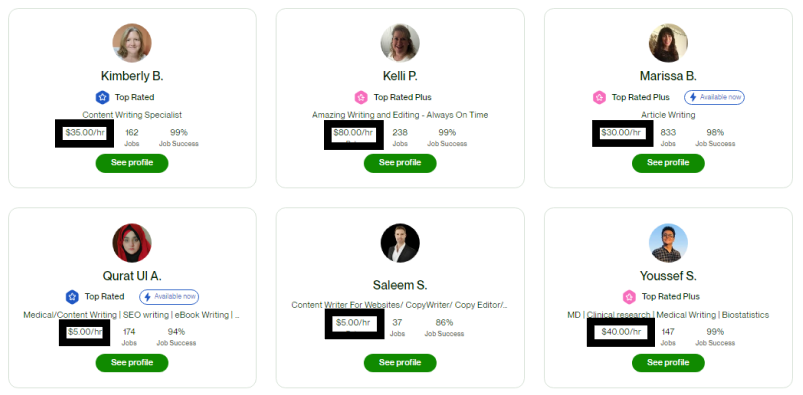
Take Your Experience and Expertise into Account
Experience matters and so does expertise. New to the industry? You might start at a lower rate, but as your portfolio grows, so does your price. Why? More experience equates to honed skills and quick turnaround times. Expertise is a ticket to higher rates. When you specialize in high-demand niches, you can command higher prices. Remember, your expertise and experience are assets. Value them! 😌
If you still don’t know how much you should charge based on your experience, this graph tells the approximate hourly rates of freelance writers based on their experience:
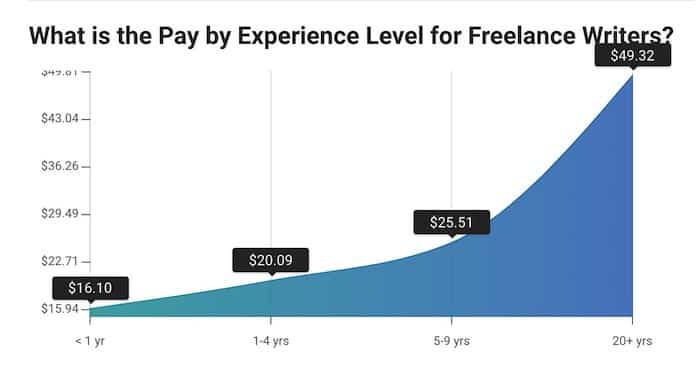
Common Pricing Models for Blog Posts
Developing Client Packages
Curating custom packages according to your strengths and client needs could prove a fruitful endeavor. 🍒 Packages might include a blog post with social media promotion or a video/vlog with promotion. Identify what clients get in each package — be it social posts, blog post elements, or videos. This allows clients to choose what aligns with their needs and budget. Value-added, personalized, and convenient. That’s the beauty of package deals!

Per Word Rate
The ”per word rate” is a common pricing model. With a range from $0.02 to over $0.15 per word, it’s popular due to ease of calculation. This is ideal for shorter content where every word counts. But remember, don’t undersell yourself! 🏋️ Even when charging per word, consider time, effort, and expertise. A fair rate per word reflects fair compensation.
| Pricing Model | How It works | Pros | Cons |
| Per Word | Writers charge a specific rate for each word in the content they produce | Fair for both parties: Payment directly correlates with the amount of work done | Uncertainty: Income can vary widely depending on the project’s word count |
| Transparent: Easily calculate costs for clients and earnings for writers | Time-Consuming: Writers need to track word count meticulously |
Flat Project Rate
A flat project rate is the go-to for 63% of freelancers. It factors in research, writing, editing, and other unseen efforts. You understand the scope and price it accordingly. This benefits clients by offering clear upfront costs, and writers by rewarding the project’s full extent, not just word count or hours. Clear, comprehensive, and equitable. The appeal is clear.
| Pricing Model | How It Works | Pros | Cons |
| Flat Rate per Project | Writers charge a fixed, predetermined fee for an entire writing project, regardless of word count or post quantity | Budget Certainty: Clients know exactly how much they’ll pay upfront | Risk for Writers: If the project becomes more complex or time-consuming, the writer may earn less per hour |
| Earnings Efficiency: Writers can complete projects more quickly without tracking individual words or posts | Scope Creep: Clients may expect additional work without additional payment | ||
| Higher Earnings Potential: Writers can earn more for complex or high-value projects | Difficulty Estimation: Pricing accurately can be challenging, especially for new writers | ||
| Experience-Based Pricing: Allows writers to price based on their expertise | |||
| Customized Packages: Writers can offer bundled services |
By the Blog Post
Charging by the blog post? Simple yet effective. This model covers the creation of a particular post, inclusive of any research, drafting, editing, and SEO optimization required. It’s especially popular for blogging where elements like images, links, and SEO efforts are crucial. In essence, it encapsulates the effort that goes beyond just writing. A single fee for a complete, well-crafted blog post. Straightforward and to the point.
| Pricing Model | How It Works | Pros | Cons |
| Per Blog Post | Writers charge a fixed rate for each blog post they write, regardless of word count | Predictable Income: Writers know exactly how much they’ll earn for each post | Risk for Clients: If the post takes longer to write, the client may pay more than expected |
| Scalability:Clients can budget precisely for their content needs | |||
| Client Convenience: Simplifies billing and budgeting for clients | Income Limitations and Drawbacks: Earnings may be limited if the client wants shorter posts |
3. Modify Your Rates According to the Type of Copywriting
The Rates for Basic, Intermediate, and Expert Writers
Writing rates evolve with expertise.
- Beginner writers often charge low, around $25-$50 per piece.
- Intermediate writers, settled and building influence, charge peaking at $100.
- Expert writers and subject matter experts see rates upwards of $100 per piece. Their deep knowledge and extensive experience are worth every penny!
Remember, these are general figures.☝️ Your rates are unique to you! 🤗
The Effectivity of High-End and Low-Level Copywriters
Let’s be candid about copywriter categorizations. High-end copywriters are specialists. They understand your brand message, engage your audience, and optimize for SEO. Their premium price tag reflects their diverse skills and expertise.
Conversely, low-level copywriters may lack depth. They often focus on delivering content that technically satisfies the brief but doesn’t necessarily engage the audience or fully embrace your branding.
Neither is wrong; just different. Choose what best fits your budget and content constraints.
4. Level Up Your Content
Content Optimization
Content optimization is a powerful tool. It’s the art of making your content more attractive to both the search engines and your readers. To do this, sprinkle relevant keywords throughout your content, craft compelling meta tags and titles, and interlink your posts. Notably, increasing your writing output can increase the success of this strategy. When done right, content optimization boosts your posts’ visibility, enhancing their chance of being found and read. So, optimize away! Improving output means more chances of reach, which translates into more money in your pocket!
Looking for an effective SEO tool to optimize your content? 🛠️ Book a demo with Outranking today!
Utilizing SEO Content Strategies
Google’s vast influence underscores the importance of SEO. It’s not simply about cramming keywords into your content. It’s about delivering meaningful, high-quality content that has been optimized not only to meet the criteria set by constantly evolving search algorithms such as those implemented by Google but also to provide superior value to your audience. Here are three ways to keep SEO content fresh:
- Leverage tools like the widely-used Google-backed Yoast SEO for guidance
- Keep current with any recent algorithm updates rolled out by Google
- Provide your readers with what they’re searching for.
The feedback from bloggers on the Google Form consolidates this approach, highlighting the importance of high-value content to achieve superior Domain Authority (DA) and attract more monthly visitors. As the adage goes, the best SEO strategy is invariably, without exception, serving your readers what they’re truly searching for.
Leveraging The Power of AI Writing Tools
While writing for your clients and for your personal branding, you should leverage the use of AI tools for generating first drafts, as well as optimizing the content pieces for SEO. Let’s consider that you have chosen a keyword to write but don’t know how much you will write. For this, there are three approaches:
- Write everything you know about the keyword and organize it accordingly
- Research the top-ranking pages for the specified keyword and write your content piece based on the information you get from those pages
- Use Outranking to obtain the necessary information you need to rank your content piece well
With the three above approaches, using Outranking is a no-brainer. Outranking researches and analyzes the top 20 ranking pages for a specified keyword and tells you how you can write better content than the rest of the ranking pages. The best part? With Outranking, AI assistance is right at your fingertips to optimize each content piece with the TLC it needs to rank. 😎
Outranking is not your average content optimization tool that gives you a thumbs-up as soon as you stuff your content with keywords. Instead, we guide you into producing as perfect a content piece as possible without using gray-hat SEO techniques. In fact, ClickWorker, a virtual workforce, saw a 1,000% increase in traffic and clicks by leveraging the power of Outranking.
Outranking helps you:
- Research Content
- Analyze SERP
- Identify User Intent
- Write Targeted Content
- Optimize SEO Content
Why should this matter to you? With the help of AI writing tools, you can expedite your content creation process to get consistent, optimized work at the press of a button. You can read a case study here on how Outranking streamlined an influencer marketing’s content creation to make them a reliable, authoritative source in their industry.
(Not to brag, but…) The great minds at Outranking are constantly making it the best source for SEO tools. To top it off, we recently updated our UI and extended content optimization to make using your website easier.
Wanna learn more about Outranking’s features? Watch the below video to get a glimpse of the power of Outranking 👇
5. Understand The Reality of Blogging Compensation
Negotiating Your Rate
Negotiating is a part and parcel of being a freelancer. Not scary, but crucial! Your rates can, and should, be flexible based on the project’s intensity, your relationship with the client, and industry standards. While adjusting, ensure it doesn’t go below what you feel is fair compensation. Negotiation respects mutual understanding. 🤝 It’s about you and your client finding a middle ground that respects both parties.
Walking Away from Low-Paying Clients
Walking away from low-paying clients might be tough, but it’s often the right thing. If a client’s budget doesn’t respect your worth, it’s a sign to walk away. When you only accept clients who value your work, you make room for those high-paying gigs that you really want! Remember, saying no can be an empowering way of saying yes to better opportunities. 💫
Your Work Is Valuable…Charge Like It!
When it comes to determining how much to charge a client for the content you create, it’s important to not undervalue yourself. Though your prices may change as you get more experience under your belt, you should always know your worth. Also, consider the cost of any optimization tools you may use to make your content the best it can be. To keep costs as low as possible for you and your clients, Outranking is the best SEO optimization tool to create well-optimized content.
Still have questions? We may have the answer! Check out our FAQs below.
Ready to face the music? 🎶
Join the 12,000+ Outranking writing maestros to compose your SEO symphony today 🎻
FAQs
How much should I charge for a 500-word article?
If you’re pondering over the price for a 500-word article, it can range anywhere from $25 to $125. Your experience, niche, and the complexity of the task can influence the rate. Entry-level writers might lean toward the lower end, while experienced ones can command higher rates, particularly if they are adept at utilizing affiliate links for enhanced performance. Considering the potential of affiliate links can also increase or decrease your rate. It is important to integrate them into your content since they draw more revenue. Always consider the value you’re providing, including the use of affiliate links which could lead to an additional commission at no extra cost to your readers.
How much should I charge for a 2,000-word blog post?
For a 2,000-word blog post, you could charge around $200. However, consider extra services like photography, SEO optimization, or even crafting relevant tweets, as these can be a source of additional income. If these require significant time, you might consider adding an add-on fee. Independent of the word count, the depth, quality, and social media visibility of your content should reflect the compensation. Bear in mind that even Twitter charges a significant rate for a single tweet.
Can I request changes to my paid blog posts?
Yes, you can! Changes or revisions, commonly part of the freelance writing process, should be discussed beforehand. Most writers allow a certain amount of revisions and corrections within the initial cost. Always be sure that the number of included revisions is clear, so you can charge the client extra if they exceed that number.
Quick tip: ask for clear and constructive feedback to understand what the client needs to limit revisions.



